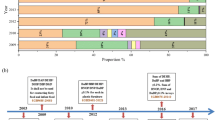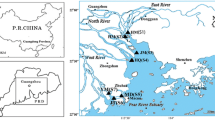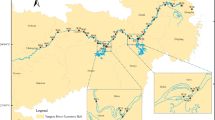Abstract
This study is the first report describing the occurrence of 15 phthalate acid esters (PAEs) in the three typical water sources of YiXing City, Taihu Upper-River Basin, East China. The fate of target PAEs in the Jiubin drinking water treatment plant (JTP) was also analyzed. The amounts of Σ15PAE in the Hengshan (HS), Youche (YC), and Xijiu (XJ) water sources were relatively moderate, with mean values of 360, 357, and 697 ng L−1, respectively. Bis(2-ethylhexyl) phthalate (DEHP) dominated the PAE concentration, making up 80% of the 15 total PAEs. The highest levels of Σ15PAE were found in HS, YC, and XJ in March 2015, January 2015, and July 2014, respectively. The occurrence and concentrations of these compounds were spatially dependent, and the mean concentrations of Σ15PAE in HS, YC, and XJ samples increased from the surface layer to the bottom layer with varied percentage increases. The removal efficiency of the PAEs in the finished water varied markedly, and the removal of PAEs by the JTP ranged from 12.8 to 64.5%. The potential ecosystem risk assessment indicated that the risk of PAEs was relatively low in these three water sources. However, risks posed by PAEs due to drinking water still exist; therefore, special attention should be paid to source control in the JTP, and advanced treatment processes for drinking water supplies should be implemented.







Similar content being viewed by others
References
Abdel Daiem MM, Rivera-Utrilla J, Ocampo-Pérez R, Méndez-Díaz JD, Sánchez-Polo M (2012) Environmental impact of phthalic acid esters and their removal from water and sediments by different technologies—a review. J Environ Manag 109:164–178
Blanchard M, Moreau-Guigon E, Dargnat C, Alliot F, Bourges C, Desportes A, Chevreuil M (2013) Phthalate fate in the hydrographic network of the river Seine Basin (France) under contrasted hydrological conditions. Water Air Soil Pollut 224:1–14
Fierens T, Servaes K, Van Holderbeke M, Geerts L, De Henauw S, Sioen I, Vanermen G (2012) Analysis of phthalates in food products and packaging materials sold on the Belgian market. Food Chem Toxicol 50:2575–2583
Fromme H, Küchler T, Otto T, Pilz K, Müller J, Wenzel A (2002) Occurrence of phthalates and bisphenol A and F in the environment. Water Res 36:1429–1438
Gavala HN, Yenal U, Ahring BK (2004) Thermal and enzymatic pretreatment of sludge containing phthalate esters prior to mesophilic anaerobic digestion. Biotechnol Bioeng 85:561–567
Gu Y (2003) Approach on the development of environmental quality standards for surface water. Shanghai Environ Sci
Guo Y, Kannan K (2011) Comparative assessment of human exposure to phthalate esters from house dust in China and the United States. Environ Sci Technol 45:3788–3794
Guo Y, Alomirah H, Cho H, Minh TB, Mohd MA, Nakata H, Kannan K (2011a) Occurrence of phthalate metabolites in human urine from several Asian countries. Environ Sci Technol 45:3138–3144
Guo Y, Wu Q, Kannan K (2011b) Phthalate metabolites in urine from China, and implications for human exposures. Environ Int 37:893–898
Guo Y, Zhang Z, Liu L, Li Y, Ren N, Kannan K (2012) Occurrence and profiles of phthalates in foodstuffs from China and their implications for human exposure. J Agric Food Chem 60:6913–6919
He W, Qin N, Kong X, Liu W, He Q, Ouyang H, Yang C, Jiang Y, Wang Q, Yang B, Xu F (2013) Spatio-temporal distributions and the ecological and health risks of phthalate esters (PAEs) in the surface water of a large, shallow Chinese lake. Sci Total Environ 461–462:672–680
Jiang J, Zhang X, Zhu X, Li Y (2017) Removal of intermediate aromatic halogenated DBPs by activated carbon adsorption: a new approach to controlling halogenated DBPs in chlorinated drinking water. Environ Sci Technol 51(6):3435–3444
Jin D, Kong X, Li Y, Bai Z, Zhuang G, Zhuang X, Deng Y (2015) Biodegradation of di-n-butyl phthalate by Achromobacter sp. isolated from rural domestic wastewater. Int J Environ Res Public Health 12:13510–13522
Kang Y, Man YB, Cheung KC, Wong MH (2012) Risk assessment of human exposure to bioaccessible phthalate esters via indoor dust around the Pearl River Delta. Environ Sci Technol 46:8422–8430
Keresztes S, Tatár E, Czégény Z, Záray G, Mihucz VG (2013) Study on the leaching of phthalates from polyethylene terephthalate bottles into mineral water. Sci Total Environ 458–460:451–458
Li J, Wang G, Aggarwal SG, Huang Y, Ren Y, Zhou B, Singh K, Gupta PK, Cao J, Zhang R (2014) Comparison of abundances, compositions and sources of elements, inorganic ions and organic compounds in atmospheric aerosols from Xi’an and New Delhi, two megacities in China and India. Sci Total Environ 476-477:485
Liu H, Cai Y, Yu MQ, Gong LT, An SQ (2012) Assessment of river habitat quality in Yixing district of Taihu lake basin. Chin J Ecol 31:1288–1295
Liu Y, Chen Z, Shen J (2013) Occurrence and removal characteristics of phthalate esters from typical water sources in Northeast China. J Anal Methods Chem 2013:419349
Mackintosh CE, Maldonado JA, Ikonomou MG, Gobas FAPC (2006) Sorption of phthalate esters and PCBs in a marine ecosystem. Environ Sci Technol 40:3481–3488
Meng X, Wang Y, Xiang N, Chen L, Liu Z, Wu B, Dai X, Zhang Y, Xie Z, Ebinghaus R (2014) Flow of sewage sludge-borne phthalate esters (PAEs) from human release to human intake: implication for risk assessment of sludge applied to soil. Sci Total Environ 476–477:242–249
Net S, Rabodonirina S, Sghaier RB, Dumoulin D, Chbib C, Tlili I, Ouddane B (2015a) Distribution of phthalates, pesticides and drug residues in the dissolved, particulate and sedimentary phases from transboundary rivers (France–Belgium). Sci Total Environ 521–522:152–159
Net S, Delmont A, Sempéré R, Paluselli A, Ouddane B (2015b) Reliable quantification of phthalates in environmental matrices (air, water, sludge, sediment and soil): a review. Sci Total Environ 515–516:162–180
Okamoto Y, Ueda K, Kojima N (2011) Potential risks of phthalate esters acquisition of endocrine-disrupting activity during environmental and metabolic processing. J Health Sci 57:497–503
Peijnenburg WJGM, Struijs J (2006) Occurrence of phthalate esters in the environment of the Netherlands. Ecotoxicol Environ Saf 63:204–215
Penalver A, Pocurull E, Borrull F, Marce RM (2000) Determination of phthalate esters in water samples by solid-phase microextraction and gas chromatography with mass spectrometric detection. J Chromatogr A 872:191–201
Peng X, Feng L, Li X (2013) Pathway of diethyl phthalate photolysis in sea-water determined by gas chromatography–mass spectrometry and compound-specific isotope analysis. Chemosphere 90:220–226
Ponzo OJ, Silvia C (2013) Evidence of reproductive disruption associated with neuroendocrine changes induced by UV–B filters, phtalates and nonylphenol during sexual maturation in rats of both gender. Toxicology 311:41–51
Schecter A, Lorber M, Guo Y, Wu Q, Yun SH, Kannan K, Hommel M, Imran N, Hynan LS, Cheng D, Colacino JA, Birnbaum LS (2013) Phthalate concentrations and dietary exposure from food purchased in New York State. Environ Health Perspect 121:473–479
Schettler T (2006) Human exposure to phthalates via consumer products. Int J Androl 29:134–139
Sha Y, Xia X, Yang Z, Huang GH (2007) Distribution of PAEs in the middle and lower reaches of the Yellow River, China. Environ Monit Assess 124:277–287
Skilhagen SE, Dugstad JE, Aaberg RJ (2008) Osmotic power—power production based on the osmotic pressure difference between waters with varying salt gradients. Desalination 220:476–482
Srivastava A, Sharma VP, Tripathi R, Kumar R, Patel DK, Mathur PK (2010) Occurrence of phthalic acid esters in Gomti River sediment, India. Environ Monit Assess 169:397–406
Stackelberg PE, Furlong ET, Meyer MT, Zaugg SD, Henderson AK, Reissman DB (2004) Persistence of pharmaceutical compounds and other organic wastewater contaminants in a conventional drinking-water-treatment plant. Sci Total Environ 329:99–113
Tan GH (1995) Residue levels of phthalate esters in water and sediment samples from the Klang River basin. Bull Environ Contam Toxicol 54:171–176
Tang W, Zeng G, Gong J, Liang J, Xu P, Zhang C, Huang B (2014) Impact of humic/fulvic acid on the removal of heavy metals from aqueous solutions using nanomaterials a review. Sci Total Environ 468–469:1014–1027
Thurén A (1986) Determination of phthalates in aquatic environments. Bull Environ Contam Toxicol 36:33–40
Vethaak AD, Lahr J, Schrap SM, Belfroid AC, Rijs GBJ, Gerritsen A, de Boer J, Bulder AS, Grinwis GCM, Kuiper RV, Legler J, Murk TAJ, Peijnenburg W, Verhaar HJM, de Voogt P (2005) An integrated assessment of estrogenic contamination and biological effects in the aquatic environment of The Netherlands. Chemosphere 59:511–524
Vitali M, Guidotti M, Macilenti G, Cremisini C (1997) Phthalate esters in freshwaters as markers of contamination sources—a site study in Italy. Environ Int 23:337–347
Wang H, Wang C, Wu W, Mo Z, Wang Z (2003) Persistent organic pollutants in water and surface sediments of Taihu Lake, China and risk assessment. Chemosphere 50:557–562
Wang W, Wu Q, Wang C, He T, Hu H (2015) Health risk assessment of phthalate esters (PAEs) in drinking water sources of China. Environ Sci Pollut Res 22:3620–3630
Xue-Li E, Chen CJ, Zhang L (2007) Study on standard for drinking water quality in China. Carcinog Teratog Mutagene 19:168–170
Yuan SY, Liu C, Liao CS, Chang BV (2002) Occurrence and microbial degradation of phthalate esters in Taiwan river sediments. Chemosphere 49:1295–1299
Yuan B, Li X, Graham N (2008) Aqueous oxidation of dimethyl phthalate in a Fe(VI)-TiO2-UV reaction system. Water Res 42:1413–1420
Yunrui Z, Wanpeng Z, Fudong L, Jianbing W, Shaoxia Y (2007) Catalytic activity of Ru/Al2O3 for ozonation of dimethyl phthalate in aqueous solution. Chemosphere 66:145–150
Zeng F, Cui K, Xie Z, Liu M, Li Y, Lin Y, Zeng Z, Li F (2008) Occurrence of phthalate esters in water and sediment of urban lakes in a subtropical city, Guangzhou, South China. Environ Int 34:372–380
Zhang L, Liang D, Ren L, Shi S, Li Z, Zhang T, Huang Y (2012) Concentration and source identification of polycyclic aromatic hydrocarbons and phthalic acid esters in the surface water of the Yangtze River Delta, China. J Environ Sci 24:335–342
Zheng X, Zhang BT, Teng Y (2014) Distribution of phthalate acid esters in lakes of Beijing and its relationship with anthropogenic activities. Sci Total Environ 476-477:107
Acknowledgements
This study was supported by the Major Science and Technology Program for Water Pollution Control and Treatment (No. 2014ZX07405002) and the National Natural Science Foundation of China (No. 51608148)
Author information
Authors and Affiliations
Corresponding author
Additional information
Responsible editor: Hongwen Sun
Electronic supplementary material
ESM 1
(DOC 804 kb)
Rights and permissions
About this article
Cite this article
Kong, Y., Shen, J., Chen, Z. et al. Profiles and risk assessment of phthalate acid esters (PAEs) in drinking water sources and treatment plants, East China. Environ Sci Pollut Res 24, 23646–23657 (2017). https://doi.org/10.1007/s11356-017-9783-x
Received:
Accepted:
Published:
Issue Date:
DOI: https://doi.org/10.1007/s11356-017-9783-x




